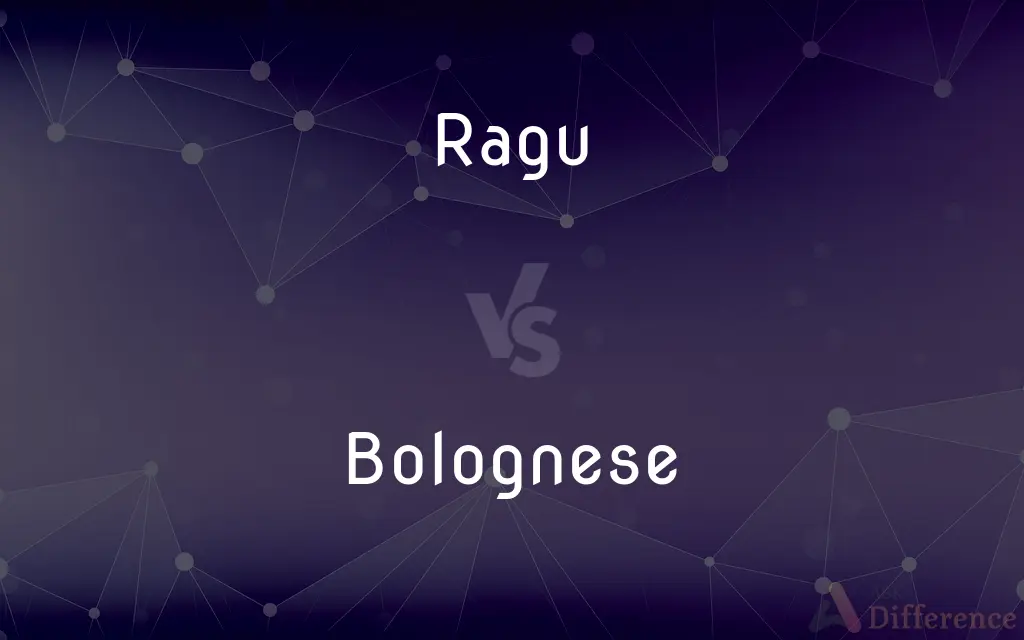Ragu vs. Bolognese — What's the Difference?
Edited by Tayyaba Rehman — By Fiza Rafique — Published on December 5, 2023
Ragu is a broad term for meat-based sauces, while Bolognese is a specific type of Ragu originating from Bologna, Italy.

Difference Between Ragu and Bolognese
Table of Contents
ADVERTISEMENT
Key Differences
Ragu is a general term that refers to a range of slow-cooked, meat-based sauces often paired with pasta. Originating from Italian cuisine, Ragu encompasses a variety of flavors, ingredients, and preparation methods. On the other hand, Bolognese is a specific kind of Ragu that comes from Bologna, Italy, characterized by its use of ground meat, tomato, onion, celery, and carrot.
While all Bolognese sauces are Ragu, not all Ragu sauces can be called Bolognese. This distinction arises from the specific ingredients and methods used in making Bolognese, which are not necessarily present in all Ragu sauces. Bolognese is typically richer and thicker, often served with broader types of pasta like tagliatelle.
In many international cuisines, Ragu might be used as a term for various meat sauces, but its true essence lies in the slow-cooked nature that allows flavors to meld and develop. Bolognese, being a subtype of Ragu, maintains this tradition but with its unique regional twist, which has earned it a distinctive place in the culinary world.
The terminologies often confuse many, especially outside of Italy. While Ragu serves as an umbrella term for multiple preparations, Bolognese stands out with its distinct taste, ingredients, and origin, proving that while all Bolognese is Ragu, the converse isn't true.
Comparison Chart
Definition
Broad term for meat-based sauces
Specific type of Ragu from Bologna, Italy
ADVERTISEMENT
Main Ingredients
Varies; meat is essential
Ground meat, tomato, onion, celery, and carrot
Serving Pasta
Can vary depending on the type of Ragu
Often tagliatelle
Region of Origin
Italy, various regions
Bologna, Italy
Consistency
Can vary from thin to thick
Typically rich and thick
Compare with Definitions
Ragu
Ragu is an Italian term for meat-based sauces.
The spaghetti was topped with a flavorful Ragu that simmered for hours.
Bolognese
Bolognese is a Ragu sauce originating from Bologna, Italy.
The chef's Bolognese recipe has been passed down for generations.
Ragu
Ragu is a slow-cooked sauce, allowing flavors to meld.
The secret to a good Ragu is patience and quality ingredients.
Bolognese
Bolognese features ground meat, tomatoes, and specific vegetables.
The key ingredients in Bolognese are finely chopped celery, carrots, and onions.
Ragu
Ragu can be made with various meats and ingredients.
Tonight's Ragu features pork and red wine for added depth.
Bolognese
Bolognese is traditionally served with tagliatelle pasta.
The restaurant's tagliatelle Bolognese is their signature dish.
Ragu
Ragu is versatile, pairing well with many pasta shapes.
Whether it's penne or pappardelle, Ragu is always a great choice.
Bolognese
Bolognese is a staple in Northern Italian cuisine.
While in Bologna, tasting an authentic Bolognese is a must.
Ragu
Ragu is foundational in Italian cuisine, with regional variations.
Traveling through Italy, one can experience different versions of Ragu.
Bolognese
Bolognese has a rich and thick consistency.
A good Bolognese should coat the pasta perfectly without being too runny.
Ragu
A thick, slowly cooked, meat-based sauce, to which vegetables, milk, and wine may be added, typically served over pasta.
Bolognese
Also Bo·lognan (bə-lōnyən) Of, relating to, or characteristic of Bologna, Italy.
Ragu
Alternative spelling of ragù
Bolognese
Being or served with a sauce containing meat, tomatoes and other vegetables, and often wine and cream
Spaghetti Bolognese.
Bolognese
Also Bolognan A native or inhabitant of Bologna, Italy.
Bolognese
Bolognese sauce.
Bolognese
An Italian sauce made of ground meat and tomato.
Bolognese
A dish served with bolognese.
Bolognese
Of or pertaining to Bologna.
Common Curiosities
What pasta pairs best with Bolognese?
Traditionally, Bolognese pairs best with tagliatelle.
Is Bolognese a type of Ragu?
Yes, Bolognese is a specific type of Ragu from Bologna, Italy.
Does Ragu always contain tomatoes?
No, not all Ragu sauces contain tomatoes, but Bolognese typically does.
Can all Ragu sauces be termed as Bolognese?
No, only a specific type of Ragu that follows the Bolognese method and ingredients can be termed as such.
Is Ragu similar to a stew?
While both are slow-cooked, Ragu is more of a sauce, whereas stew is a complete dish with solid ingredients in a liquid.
What is Ragu in the context of Italian cuisine?
Ragu is a slow-cooked meat-based sauce typically served with pasta.
Why is Bolognese sauce so popular worldwide?
Its rich flavor, combined with its versatility in pasta dishes, has contributed to its global appeal.
Can Ragu contain poultry or is it strictly red meat?
Ragu can be made with a variety of meats, including poultry.
Is Bolognese traditionally spicy?
No, traditional Bolognese is not spicy, but variations exist.
How long should a Ragu traditionally be cooked?
A traditional Ragu benefits from slow cooking, often for several hours.
How do Ragu and Bolognese differ in flavor?
While both are meaty and rich, Bolognese typically has a more specific flavor profile due to its defined set of ingredients.
What wine pairs best with Bolognese?
A robust red wine, like Chianti or Sangiovese, pairs well with Bolognese.
Does Bolognese always use beef as its meat?
While beef is common, Bolognese can also be made with pork or a mix of meats.
Is Ragu the same as the jarred sauce sold in supermarkets?
Commercial "Ragu" sauces might be inspired by the traditional dish but can vary widely in authenticity.
Is there a vegetarian version of Ragu or Bolognese?
Yes, there are vegetarian and vegan versions that use alternatives like lentils or mushrooms.
Share Your Discovery

Previous Comparison
Ideal Gas vs. Real Gas
Next Comparison
Proforma Invoice vs. InvoiceAuthor Spotlight
Written by
Fiza RafiqueFiza Rafique is a skilled content writer at AskDifference.com, where she meticulously refines and enhances written pieces. Drawing from her vast editorial expertise, Fiza ensures clarity, accuracy, and precision in every article. Passionate about language, she continually seeks to elevate the quality of content for readers worldwide.
Edited by
Tayyaba RehmanTayyaba Rehman is a distinguished writer, currently serving as a primary contributor to askdifference.com. As a researcher in semantics and etymology, Tayyaba's passion for the complexity of languages and their distinctions has found a perfect home on the platform. Tayyaba delves into the intricacies of language, distinguishing between commonly confused words and phrases, thereby providing clarity for readers worldwide.











































